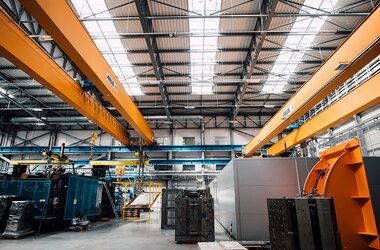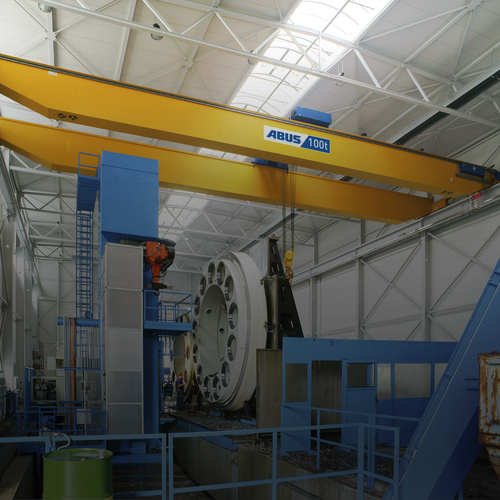Jelenia Plast’s investment in development using ABUS’ cranes
It is quite challenging to produce a wide variety of plastic products: you have to overcome many a technological and organisational hurdle. Cranes have an important role to play in the production process as they not only afford precise positioning of the load but are also characterised by a high degree of reliability and availability. This is the very reason why the Polish company Jelenia Plast—situated in the foothills of the Giant Mountains—have decided again to buy cranes of the ABUS brand.
Jelenia Plast (www.jeleniaplast.com), have been manufacturing household and gardening items using injection moulding and rotational technique since 1992 and employ 400 staff. Increasing demand for their products led Jelenia Plast to expand their production plants in Jelenia Gora. The investments made in this recent development of the company led to many new jobs being created. Additional investment in the means of production will further increase productivity in the near future also.
Jelenia Plast’s plastic products are made using injection moulding. The complexities of the products to be produced govern the weights of the injection moulds: the weights range from 4 to 25 tonnes. These injection moulds are fixed inside the injection moulding machines by means of special hooks. Pin-point precision is required for the installation—and dismantling—of these moulds inside the injection moulding machines and is a decisive factor for the continuity of the manufacturing process as a high degree of precision is required when positioning heavy loads. EOT cranes and hoists have to meet these requirements.
ABUS technology had been used in the production of Jelenia Plast even before the new order was placed. Jelenia Plast put particular emphasis on the reliability of hoists and thus decided to buy ABUS EOT cranes for this new investment. The newly built production plant saw three double girder EOT cranes installed: two cranes with load capacities of 10 tonnes and a further crane with 40 tonnes SWL. All three cranes share relatively large spans of 36 metres.
All cranes are frequency controlled thus being able to precisely position the injection moulds. The ABUliner frequency converter for long travelling on the 40 tonne crane makes continuously variable acceleration—and keeping any selected speed—possible. The ABUliner is controlled manually from a control unit on the crane. The ABUliner also reduces load sway in the direction of crane travelling. Both 10 tonne cranes are frequency controlled in all motion directions: not only for long travelling, but also for cross travelling and lifting / lowering so that the load, i.e. the injection mould, may be placed with pin point precision as required. All cranes feature LED segment load displays on the main girders. It is possible to read the loads on these LED segment load displays from distances of up to 50 metres depending on the visibility conditions. The crane user who knows the weight of the mould he is lifting compares this with the load displayed on the crane and thus is informed whether the mould is yet resting completely on all hooks. He is thus able to counteract load sway right from the start when the mould is lifted out of the injection moulding machine preventing damage to be caused to the machine parts.
The ABUS remote control ABURemote (joystick) is used to control the EOT cranes. Remote control enables the crane user to move freely and safely in the area of the production machines while keeping an eye on the positioning of the moulds at the same time. In addition, LED lights were installed on the main girders to light up the working areas of the hooks in particular.
Another special feature of this project lies in the fact that two EOT cranes run on the same crane track keeping their distances thanks to a crane distancing system. The third EOT crane works on a crane track above them. A collision protection in the form of a light barrier on this third crane stops it as soon as a crane on the lower crane track approaches. The cranes are not only used to install and dismantle the moulds but they also transport the moulds to a special area in the production plant that has been reserved to check, repair, and maintain the injection moulds as well as the injection moulding machines. The EOT cranes have been purposefully placed onto two levels in order to compensate for a possible risk of unavailability which might arise during particular intense phases of maximum workloads during which moulds need changing while servicing or repairs are going on simultaneously.
The complete project was managed by ABUS Crane Systems Polska (www.abuscranes.pl), the Polish daughter company of ABUS Kransysteme in Gliwice. ABUS Crane Systems Polska offered the complete service package: assisting with the optimal selection for this particular material flow, delivery and installation, as well as after-sales service.
















